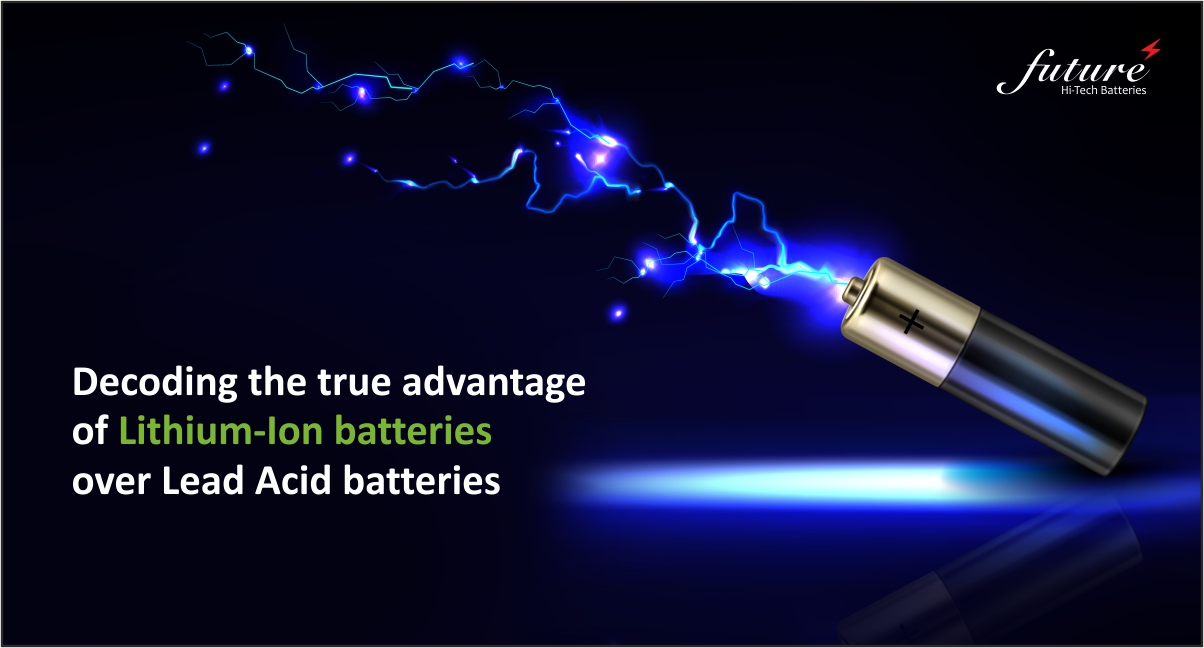Electric Vehicle (EV) technology has been around for a while now, but it’s essential to understand the technology behind what drives EVs.

Lorem ipsum dolor sit amet, nec in adipiscing purus luctus, urna pellentesque fringilla vel, non sed arcu integer, mauris ullamcorper ante ut non torquent.
Battery packs are considered to be at the heart of electric technology, and these power sources do not store electricity as a whole but contain chemicals that react to produce an electric current. The level of current used in electric automotive propulsion relies on two types of batteries – lead-acid and lithium-ion. We’re here to understand both and which proves to be the best in EV application and why.
Lead-acid and lithium-ion batteries share the same working principle based on electrochemistry. They store (charge) and release (discharge) electrons (electricity) through electrochemical reactions. While discharging, Lithium ions (Li+) are exchanged between the negative electrode (anode) and the positive electrode (cathode). To balance the reaction, electrons are released from the negative electrode to the positive electrode. While charging, the opposite reaction occurs, and electrons are flowing from the positive electrode to the negative. For lead acid, similar reactions occur, but in this instance, it is the acid electrolyte (H2SO4) that participates in the reaction with 2H+ (aqueous protons).
Energy Storage & Maximum Depth of Discharge
Lithium is the lightest metal on earth, one kg of lithium contains 29 times more atoms than lead. In addition, the working voltage of Lithium-Ion is 3.2V vs 2V for lead-acid. Consequently, you can store much more energy in 1kg of lithium battery than in lead-acid. You also may have noticed that the manufacturer advises not to discharge the battery below 50% of its full capacity to improve its life duration. In lead-acid batteries, over-discharging creates parasite reactions (sulfation) at the electrodes, slowly damaging the system. Conversely, degradations in lithium batteries only start when the depth of discharge reaches 60%, therefore manufacturers recommend 80% DOD to improve their total life duration. Recent improvement enables 100% DOD without extra damage to the battery.
Cost
The one category in which lead-acid batteries seemingly outperform lithium-ion options is in their cost. A lead acid battery system may cost hundreds or thousands of dollars less than a similarly-sized lithium-ion setup – lithium-ion batteries currently cost anywhere from $5,000 to $15,000 including installation, and this range can go higher or lower depending on the size of system you need.
While lead acid batteries typically have lower purchase and installation costs compared to lithium-ion options, the lifetime value of a lithium-ion battery evens the scales. Below, we’ll outline other important features of each battery type to consider, and explain why these factors contribute to an overall higher value for lithium-ion battery systems.
Durability
Durability is one of the most important factors to consider when buying a product. With only 2 years of good service (when discharged at 50% of its maximum capacity) the life duration is extremely low, especially for a century-old technology. If deeply discharged at each cycle (80% or more), your lead-acid battery will only work well for 350 cycles or one year. Over time, battery capacity degrades due to sulfation of the battery and shedding of active material. The degradation of battery capacity depends most strongly on the interrelationship between the following parameters: the charging/discharging regime which the battery has experienced. On the other hand, the minimum lifespan most manufacturers expect from lithium-ion batteries is around 5 years or at least 2,000 charging cycles. But, if well cared for and used in proper conditions, lithium-ion batteries can last as long as 3,000 cycles.
Charging Efficiency & Lifespan
Battery efficiency is an important metric to consider when comparing different options. Most lithium-ion batteries are 95 percent efficient or more, meaning that 95 percent or more of the energy stored in a lithium-ion battery is actually able to be used. Conversely, lead acid batteries see efficiencies closer to 80 to 85 percent. Higher efficiency batteries charge faster, and similarly to the depth of discharge, improved efficiency means a higher effective battery capacity.
Lithium-Ion batteries offer a significant advantage over other battery types
High energy density:
High energy density is one of the chief advantages of lithium-ion battery technology. With electronic equipment such as mobile phones needing to operate longer between charges while still consuming more power, there is always a need for batteries with a much higher energy density. For example, NiMH batteries would not be able to provide the charge capacity required for a modern smartphone. Using Nickel Metal Hydride battery technology, a smartphone would not last long enough, especially if the battery needed to keep within the same size constraints.
In addition to this, there are many power applications from power tools to electric vehicles. The much higher power density offered by lithium-ion batteries is a distinct advantage. Electric vehicles also need battery technology that has a high energy density.
Self-discharge:
One issue with many rechargeable batteries is the self-discharge rate. Lithium-ion cells are that their rate of self-discharge is much lower than that of other rechargeable cells such as Ni-Cad and NiMH forms. It is typically around 5% in the first 4 hours after being charged but then falls to a figure of around 1 or 2% per month.
Low maintenance:
One major lithium-ion battery advantage is that they do not require any maintenance to ensure their performance.
Ni-Cad cells required a periodic discharge to ensure that they did not exhibit the memory effect. As this does not affect lithium-ion batteries and cells. This process or other similar maintenance procedures are not required. Likewise lead acid cells to require maintenance, some needing the battery acid to be topped up periodically.
Cell voltage:
The voltage produced by each lithium-ion cell is about 3.6 volts. This has many advantages. Being higher than that of the standard nickel-cadmium, nickel metal hydride, and even standard alkaline cells at around 1.5 volts and lead acid at around 2 volts per cell, the voltage of each lithium-ion cell is higher, requiring fewer cells in many battery applications. For smartphones, a single cell is all that is needed and this simplifies the power management.
Lithium-ion batteries offer more reliable performance, require less maintenance, and have a higher power density than lead acid batteries. Lithium-ion batteries last 2-3 times longer than lead-acid batteries, resulting in fewer battery replacements and lower labor costs. Lithium-ion batteries can now provide a lower total cost of ownership (TCO) than lead acid batteries in as little as 5 years. Lithium-ion batteries are currently used in most electric vehicles because of their high energy per unit mass relative to other electrical energy storage systems. They also have a high power-to-weight ratio, high energy efficiency, good high-temperature performance, and low self-discharge.










Your Comment Please